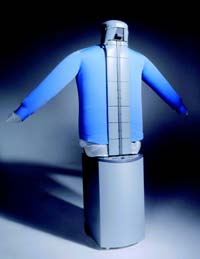

Generative AI has been making waves ever since its inception. Researchers are discovering novel ways to simplify our lives through digital means. In recent years, innovators have employed Gen AI to assist in the physical world, too.
Researchers from the University of Oxford, in artificial intelligence, have forecasted that up to 40% of household chores, such as cooking, laundry, and cleaning, will be automated in the next 10 years. This is especially beneficial for working individuals by fostering a happy work-life balance. The Dressman robot is one such innovation that assists people in drying and ironing their garments.
Ironing out Problems—Dressman Robot
The main objective of the Dressman robot is to dry and press shirts. On placing a damp shirt on the ironing figure, this dummy inflates with hot air in its interior, and thus puffs the shirt up, removing creases drying the garment (it has to be previously wet and undergone a spin-dry in a washing machine).
The device has a heater box inside with a number of different resistance elements. While we are placing the shirt on it, this box stores up heat in such a way that, when the garment is positioned and we press the start button, the whole ironing dummy fills with hot air which presses and dries the shirt. Moreover, the device has an air filter which prevents dirt entering the ironing dummy.
The time for the ironing process is selected by the user. The temperature of the resistance elements is not, only the cycle time, which lasts from 4 to 15 minutes, depending on the type of cloth in the shirt being ironed (a normal cotton shirt usually takes 7-8 minutes). These times are selected on a rotary selector that is on the device itself.
When the ironing process has finished the device blows cold air for 1 minute in order to stabilise the cloth and thus prolong the effect of the ironing.
The size of the dummy adjusts perfectly to that of the garment, allowing the pressing of all kinds of shirts, including short-sleeved ones. Moreover, we can use the apparatus for all kinds of cloth, except for elastic ones, as the air pressure will make the garment.
Apart from the ironing cycles with the rotary selector, we can select a cycle where only cold air is blown simply in order to ventilate shirts and jackets.
The ironing dummy is made up of three different types of cloth, each with a distinct permeability and, thus, allowing more or less hot air to the exterior. The reason for this is that more hot air flow is needed in some areas of the shirt than in others because the cloth thickness is greater or there is a double layer of cloth (for example in the pocket zone or at the cuffs. What is more, ironing dummy can be washed in the washing machine.
One of the advantages of this device is that, while the frame of the iron can get to very high temperatures, the temperature of the dummy never gets to damage the garment. Moreover, the base of a conventional iron crushes the cloth, in such a way that it loses its pristine look after a few ironings. However, with this ironing robot system, the cloth is maintained undamaged for longer periods and the shiny patches that appear on certain materials with conventional irons.
Some numerical data:
- The device measures 173 x 36.5 x 45 cm when in the upright position and, when folded, the height is 119 cm.
- Its weight is 28 kg. It has wheels and a handle by which it can be easily moved from place to place.
- It consumes about 3300 W or 2150 W. The user has the choice, by pressing a button combination, of having the machine work with 2150 W and, thus, consume less energy.
Taking Innovation to the Next Level—Humanoids
Meet the new human-like machines doing household chores—Humanoids. Powered by AI, these robots not only assist around the house, but they might contend as butlers in the near future. Bernt Børnich, a Norwegian engineer, has developed a talking-moving robot, Neo, which he hopes to have it distribute to more than 100 homes around Silicon Valley and ultimately globally. Sharing workload is the most sought-after assistance, and with such innovative technology, people’s lives will tend to unfold a lot easier, physically, mentally, and emotionally.
Benefits of AI Technology in Household Settings
Innovation is not only intended to simplify lives but also to cut back on costs. Today, normal household appliances are getting an AI makeover, such as voice-controlled assistants and monitoring devices. Technologies including security cameras, smart appliances such as AI fridges, robot vacuum cleaners, smart thermostats and metres, and smart locks have a way of enhancing consumer experience while securing households.
The Future of Domestic Life: Smart Technology
Generative AI continues to evolve and expand its integration into our homes. From the Dressman robot easing ironing routines to humanoid assistants like Neo, domestic AI support is growing. By lifting the burden of mundane household chores, people’s quality of life is improved. As advanced technology infuses into household appliances, the dream of intelligent, hands-free, easy living is turning into reality. With time-saving and cost benefits along with energy-efficient designs, the future of domestic life looks promising. Smart technology balances out individual lives, creating more space and time for what and who truly matters.












